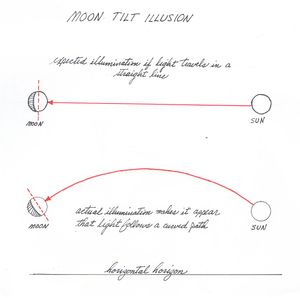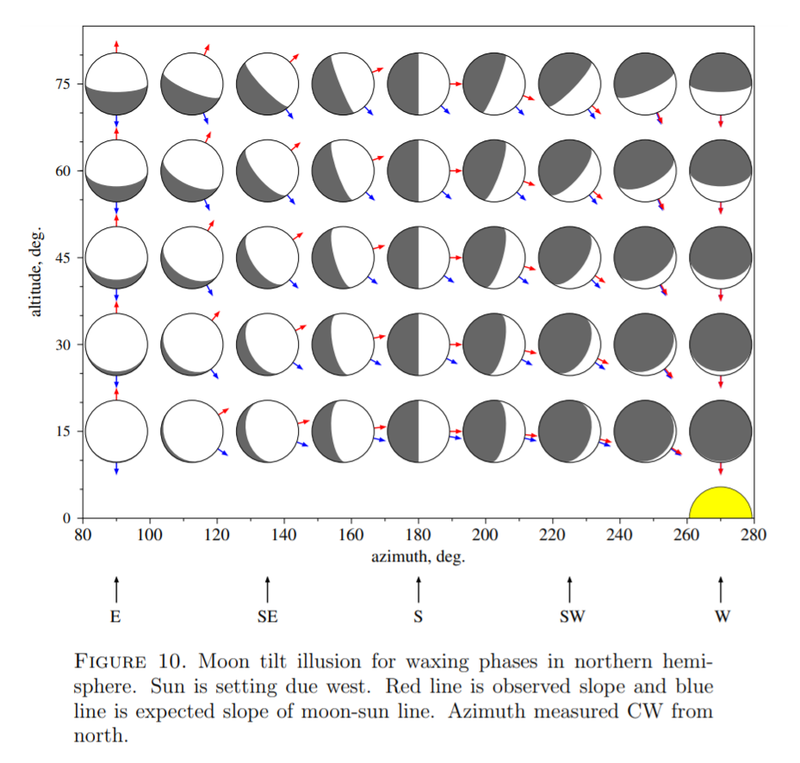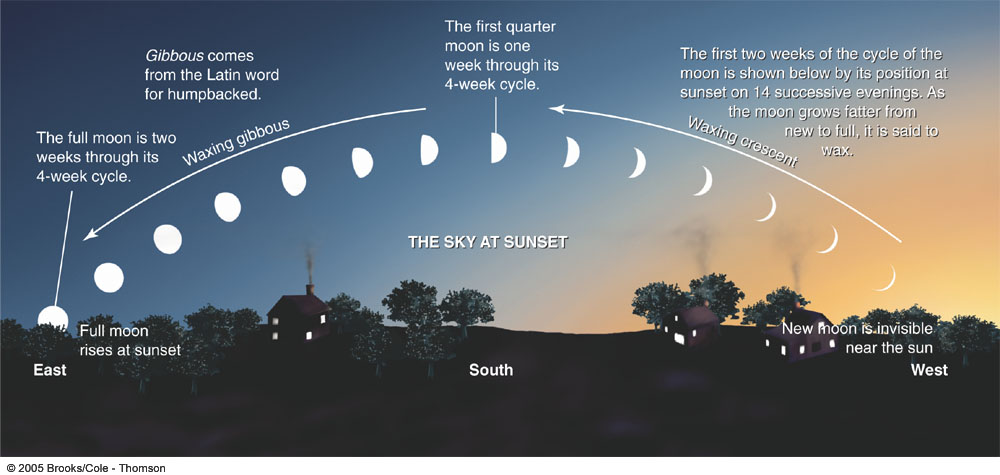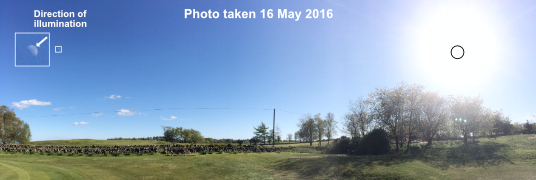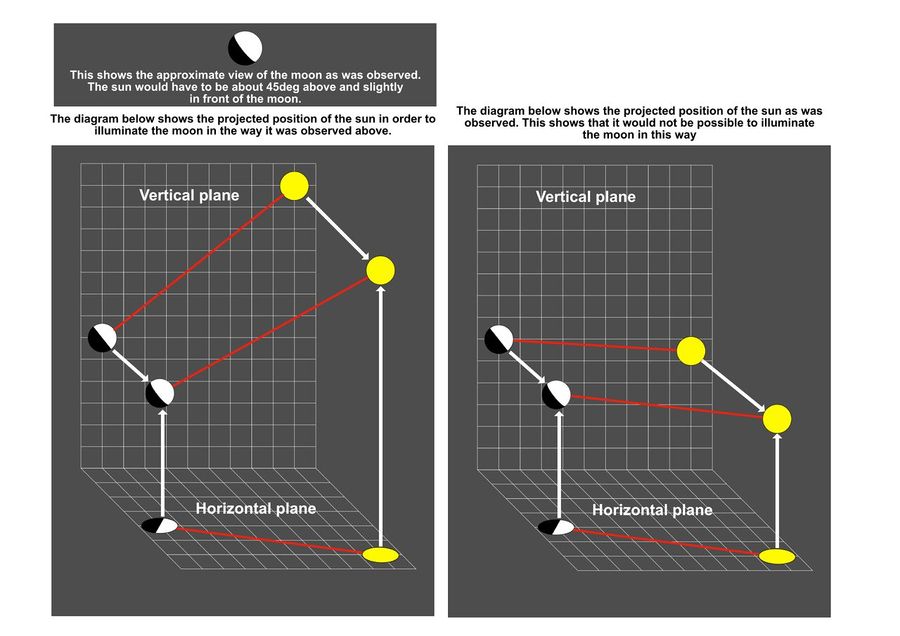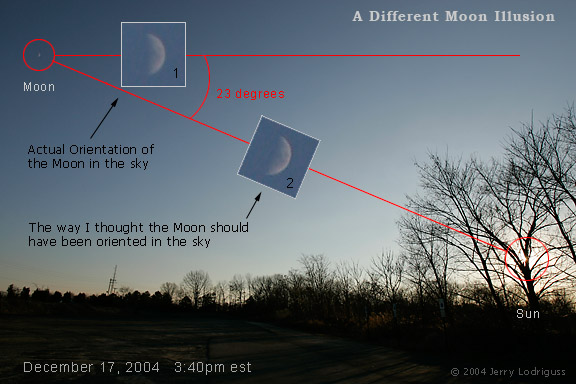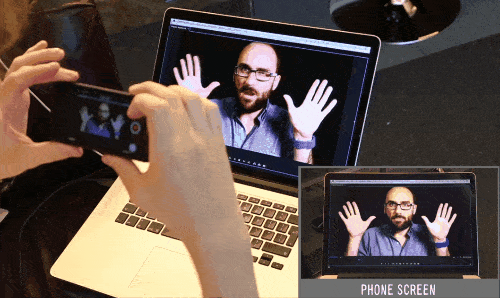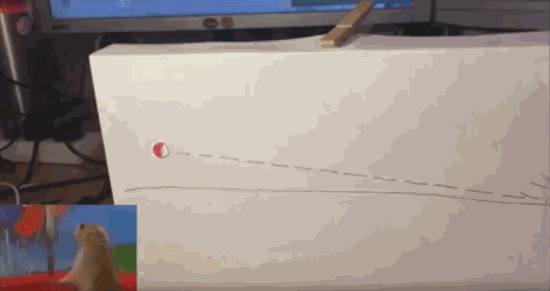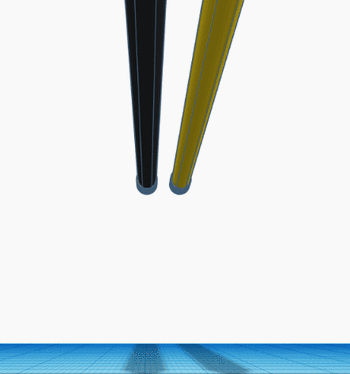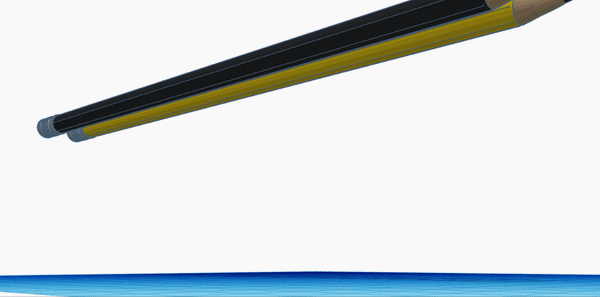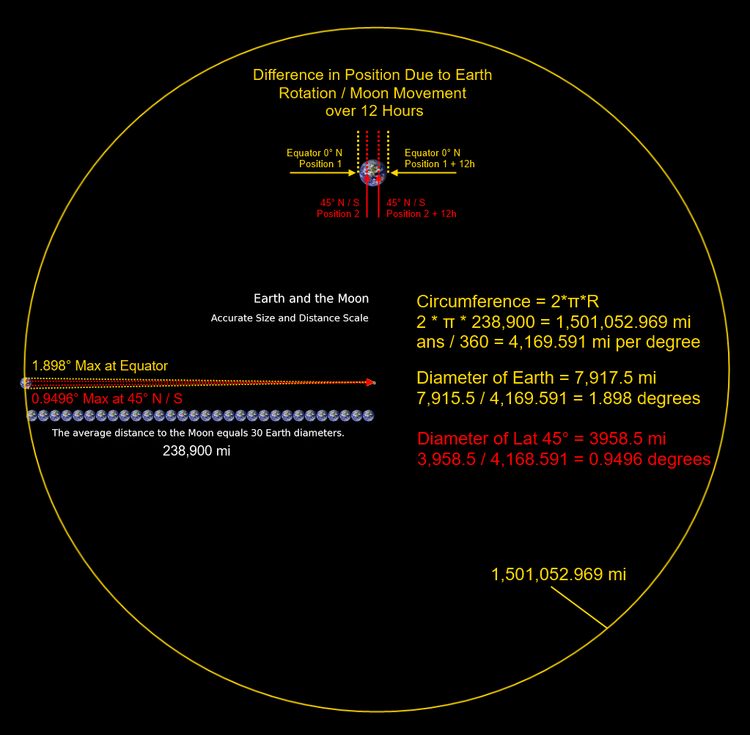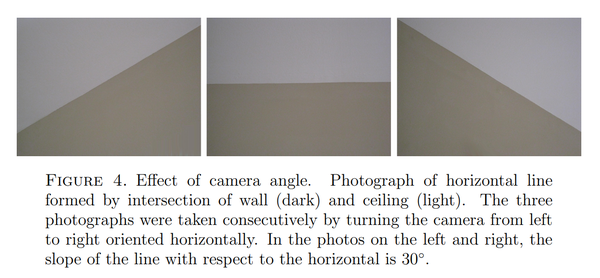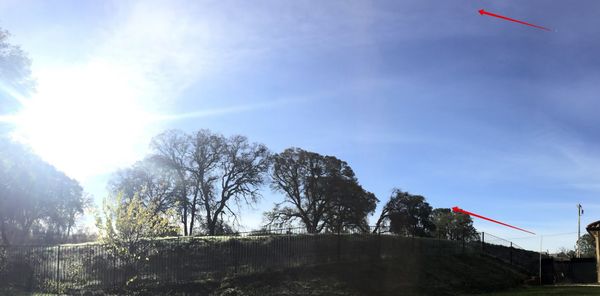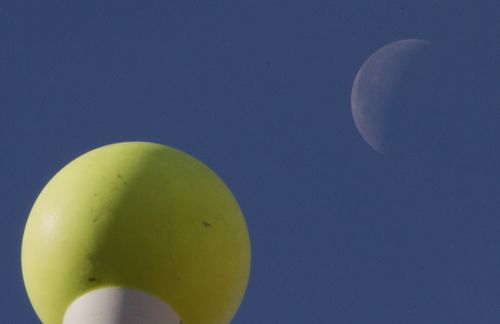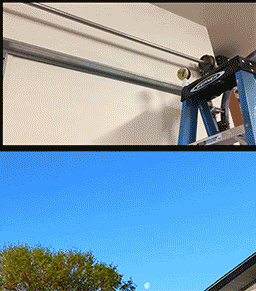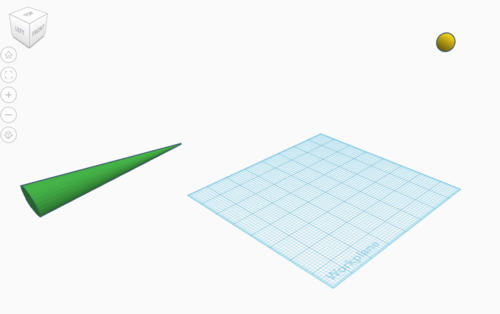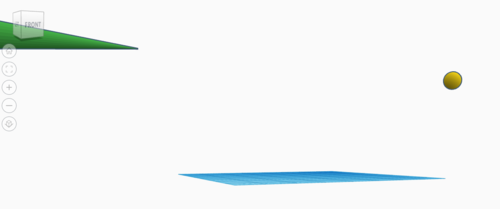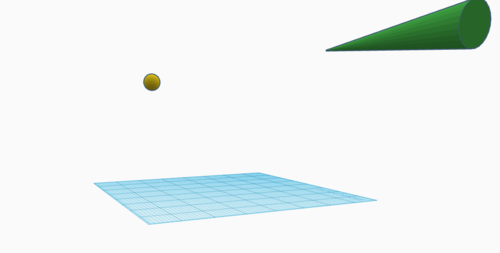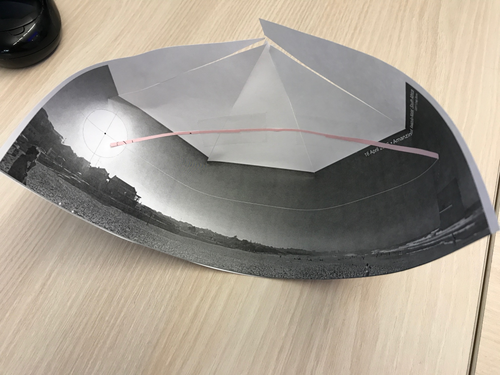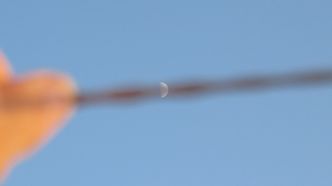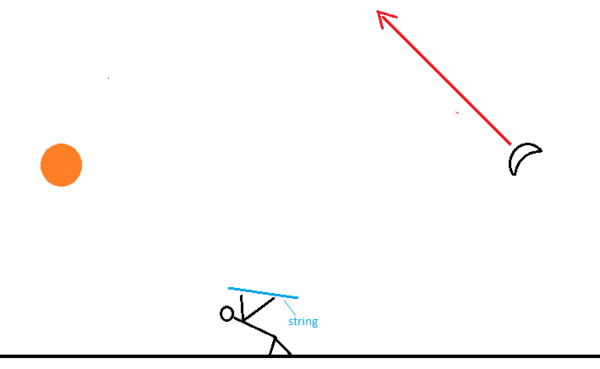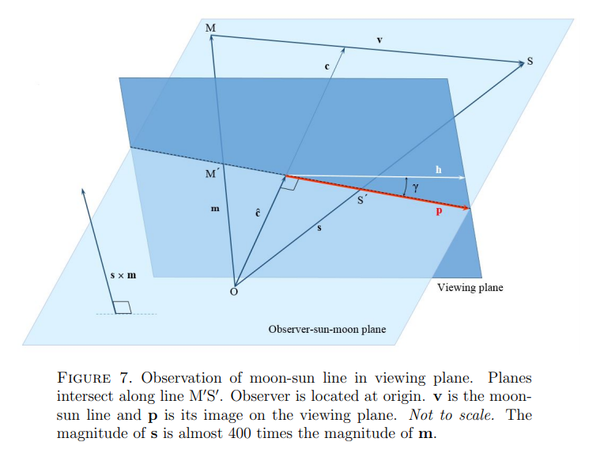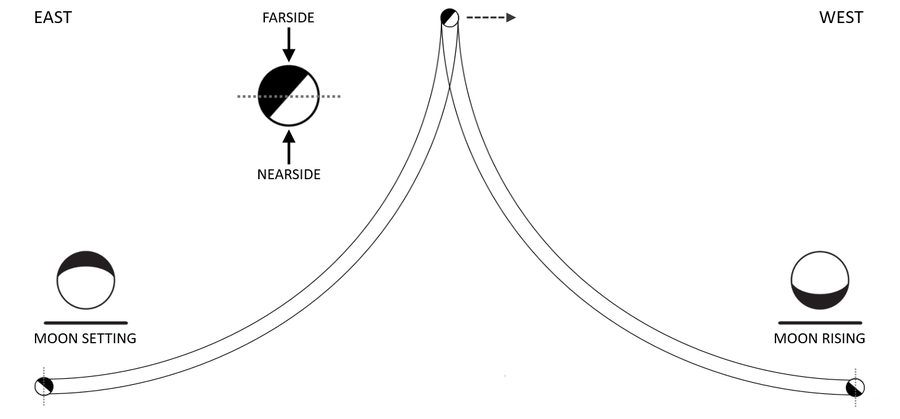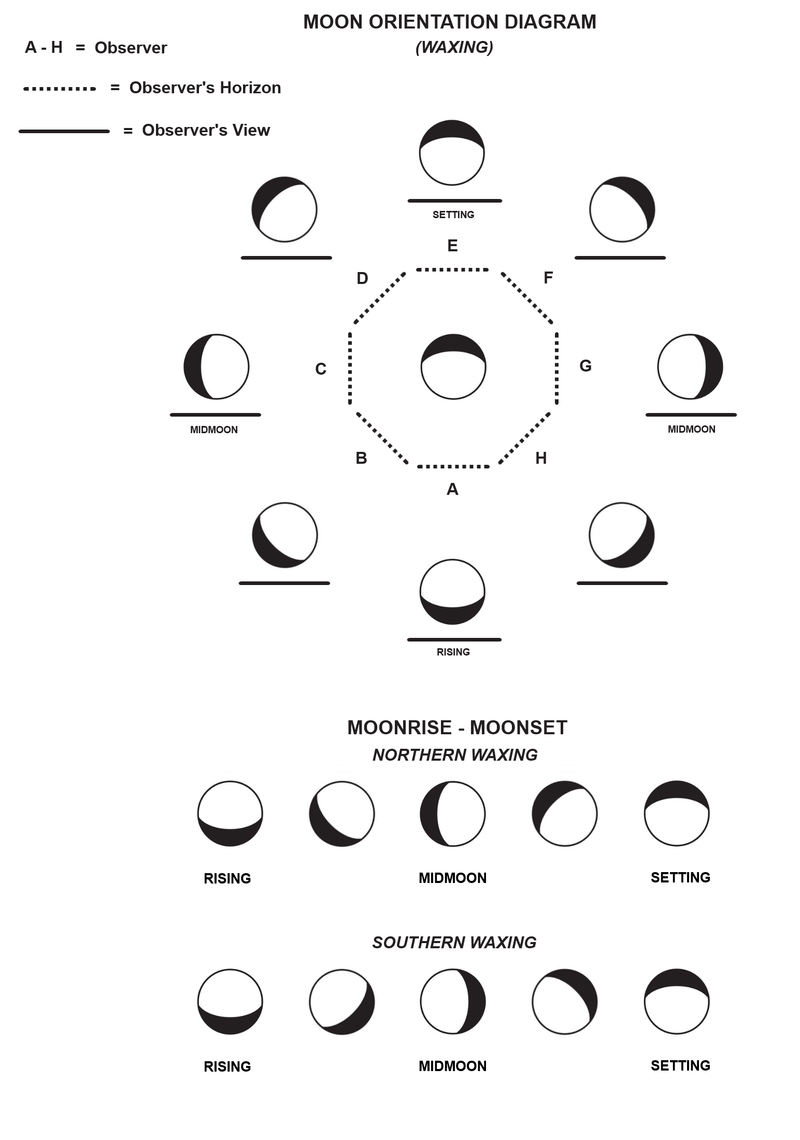Moon Tilt Illusion
If the Moon is illuminated by the Sun it is expected that its illuminated portion should always point at the Sun. The Moon Tilt Illusion is a phenomenon in which the lit portion of the Moon unexpectedly points away from the Sun. The phenomenon is most noticeable for gibbous phases between Half Moon and Full Moon and during the time between the Moon's rising and zenith. The Moon Tilt Illusion even occurs after the Sun has set, a situation in which the the Moon is pointing upwards and away from the Earth while the Sun is below the horizon.
Some attribute this phenomenon to 'perspective'. Others speculate on a 'celestial sphere' which the celestial bodies glide upon, and upon which straight lines become curved. We are given a series of analogies and explanations separate from, and incompatible with, the Round Earth Theory.
The Moon Tilt Illusion is geometric anomaly predicted by the Flat Earth Theory. Under the FET the Moon Tilt is directly predicted by Electromagnetic Acceleration (EA). The nature of EA results in the tilt of the Moon's phase away from the Sun and, for those who will accept the proof when furnished, acts as a vivid piece of evidence for the Flat Earth celestial model which is visible and accessible to all.
Description
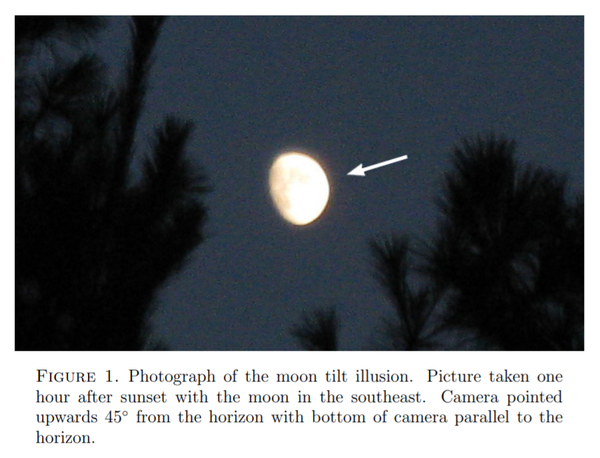
(Source)
Professor Myers at the University of Pennsylvania provides the following description:
http://www.upenn.edu/emeritus/essays/MyersMoon.html (Archive)
“ One evening several years ago, I took this picture of the misty glow of an almost full moon shining between pine trees in my backyard. The moon was beautifully illuminated and dominated the dark sky. Yet something was disturbing about the atmospheric night scene: the illumination of the moon seemed to be coming from the wrong direction! In this photograph of a waxing moon in the southern sky, its illumination appears to be coming from above to the right. But the sun---which had set an hour earlier---was already below the western horizon to the right when this photo was taken. If the sun is below the horizon, I thought, shouldn't its illumination of the moon appear to be coming from below the horizon? Intrigued, I made further observations when both the sun and the moon occupied the evening sky at the same time, and it certainly seemed that light rays from the sun would have to follow a curved path to shine on the moon at the observed angle. The sketch drawn below may help to explain the difference between what I expected to see and what I actually saw.
I asked everyone willing to listen if they were familiar with this illusion: why does a light ray from the sun to the moon appear to follow a curved path? No one had seen or heard of it. Several imaginative explanations were offered: "The light rays are bent by the earth's atmosphere." Or, "Gravitational lensing as predicted by Einstein's general theory of relativity is responsible." I was surprised not to find the illusion described in astronomy textbooks. I googled "moon illusion" but the articles were about an entirely different illusion: the apparent magnification of the full moon when it's close to the horizon.
Finally, help came from my daughter, who located published papers by googling "moon tilt illusion". The scientific explanation is based on the projection of a straight line onto the surface of a sphere. A simpler explanation was provided in a conversation with Benjamin Shen, Professor Emeritus of Astronomy at Penn, who said that light appears to follow a great circle route from the sun to the moon. That's why the moon's lit face appears to us not to face the sun squarely, regardless of whether the sun is above or below the horizon.
The moon tilt illusion is counter-intuitive and magical---look for it the next time you are under a night sky. ”
Moon Tilt Observational Diagram
In a related paper from the same author titled The Moon Tilt Illusion (Archive), Professor Myers provides the following diagram of the observed tilt of the Moon and its displacement from the expected angle:
Altitude is the elevation of the moon in the sky. Azimuth is the degrees clockwise from North. The diagram shows phases from full to new. At times the Moon is pointing towards the Sun, and at other times the Moon is pointing away from it. When opposite from the Sun, the Moon's tilt can be wildly displaced from its expected position.
Other Versions
From the source:
“ The most impressive illusion occurs at sunset when the gibbous moon is at high altitude in the southwest or at sunrise when the gibbous moon is at high altitude in the southeast (both cases for the northern hemisphere). ”
Lunar Phases at Sunset
Another depiction of the various orientations of the Moon in relation to the Sun at the time of sunset for waxing phases in the North may be found below:
(Source)
Other Versions
Sun and Moon Anomaly
From a Stack Exchange post on the Moon Tilt Illusion we find an observation:
“ Below is a photo that my son took in Scotland showing the sun and moon at the same time. I immediately noticed this anomaly that the light illuminating the moon could not possibly come from the sun. I sent the photo to 4 University astronomy departments and only one responded and that was Cambridge University which is near where I live. The response came from the department librarian (not an astronomer) who said he had never heard of this before. He gave me two possible solutions, one was was from an engineer (not an astronomer) in which he got confused between perspective and light ray tracing and the other was referring to Einstein's theory of light bending by gravity. I check out Einstein and the effect was so small as to be almost immeasurable. ”
“ I have looked at the various 'complex' explanations for what to me is a very simple model. What need is there to introduce 'curved planes' and 'starry sky domes' all of which do not exist in reality? It is only referred to as an 'illusion' because observation doesn't fit the conventional model hence the complex explanations to try and make it work. The anomaly is acknowledged to exist with or without photos. Since everyone believes that the moon is illuminated by the sun then simple normal physics do not seem to work. Either the physics is wrong or the sun does not illuminate the moon. I realise that is a heavy statement!
Therefore I state once again:
- The sun and the moon are two objects (like a torch and a football) that are suspended in a 3 dimensional space and size should not matter.
- The moon/football are illuminated by the sun/torch and a perpendicular line or light ray can be drawn between them.
- It doesn't matter where in space you choose to view them, a perpendicular line or light ray can still be drawn between them.
This drawing explains my doubts: ”
“ I'm very surprised that some of you have never noticed it before hence the suggestion asking me to post a video. This is a very common occurrence and I have seen it many many times as I go for my morning walk at about 8.00am every morning. I have never thought of actually tabulating my observations. ”
A Different Moon Illusion
Another observation is given here:
http://www.astropix.com/html/l_story/moonill.html (Archive)
“ Now, I have always under the impression that if you took the Moon's phase illumination angle it would draw a line straight back to the sun. But this sure wasn't what I thought I saw this day.
Obviously, it's an illusion that has something to do with a three-dimensional space being projected onto a two-dimensional plane in my eyeballs. Some people have tried to explain it as involving great circles, just as airplanes fly great circle routes to places on the opposite side of the globe. However they only do this because they can't fly a straight line through the Earth.
What I can't seem to get past is that the Sun and the Moon were in the same field together and I could view them both at the same time and that the light from the Sun is going in a straight line from the Sun to the Moon. It is not following a great circle. ”
Explanations
Perspective Explanations
An explanation of the Moon Tilt Illusion is given in the form of a perspective effect. It is possible to get very close to an object and make it appear to change angle and point upwards, downwards, or to the side. It is claimed that this is occurring with the Moon.
A VSauce video titled The Moon Terminator Illusion (Runtime:11m) explains the Moon Tilt Illusion via a perspective effect:
In the above demonstration VSauce references a close range perspective effect to show that orientation of bodies and images can change to perspective. However, one will find that that same effect is not going to occur with the same motions of the camera if the screen is distant from the observer. If the laptop screen were far away the the camera would need to move of greater proportions. The same movement would not create the same effect.
Another version of the perspective argument is given here:
The Moon is pointing downward at the Sun at the horizon. Moving the camera close to the Moon, the Moon appears to point upwards.
In contrast to this argument, under the Round Earth Theory both the Sun and the Moon are far away from the observer and are at the same distance from the observer at all times. They do not change distances radically from the observer, as the camera changes in relation to the Moon in the above animation in order to cause a large perspective effect. The explanation of a perspective effect is extraneous to the systems in the Round Earth Theory.
Pencil Example
As an example; a pencil 10,000 feet away from the observer will not be subject to close range perspective as easily as a pencil held 10 inches away, where the observer can cause perspective changes with small movements.
For a personal example, take a pencil and hold it horizontally to the ground with the end of it one inch away from your forehead. The pencil will appear to be pointing 'upwards' to your perspective, despite being horizontal to the ground. Move your head a couple of inches to the left or right and notice the pencil's apparent range of movement. Next, move the pencil an arms length away from your forehead, while still holding it horizontal to the ground. The pencil is no longer pointing at the same upwards angle and begins evening out. When moving your head a couple of inches to the left or right at the greater distance makes the pencil undergo smaller perspective changes.
Pencil Perspective Simulation
Indeed, perspective affects a pencil less and less with greater distance. In the below simulations the pencils are horizontal to the blue plane. At close proximity the pencils point upwards. Receding backwards away from the scene causes the pencils to even out.
Some have suggested that the Moon Tilt Illusion is due to perspective causing the moon to point upwards. Yet we see that this is only a close range effect. Consider: Presuming that you could see it, at the distance to the Moon will the pencil point upwards?
Difference in Position Diagram
According to the RET over the course of a day the changing of distance to the Moon is negligible. The Moon maintains its distance from the center of the Earth at all times, as the Moon slowly rotates around it. The Earth, in turn, rotates diurnally at a faster rate in relation to the Moon. An observer on the surface of the Earth at either side of the Equator will observe a change in the position of the Moon by less than 2 degrees due to positional changes alone, as demonstrated in the below top-down illustration:
In the above diagram the outer orange circle is the distance between the Earth to the Moon turned into a circle. Divided by 360 degrees gives the number of degrees per mile, which is used to find the displacement in degrees between the extremes of either side of the Earth. We see that the displacement in degrees is minimal.
Looking at the Earth's Diameter and the Moon's Orbit Diameter as compared to the distance to the Sun under a similar methodology we also find negligible differences in angle displacement:
- Earth Diameter: 7917.5 mi
- Diameter of Moon Orbit: 238,900 mi (Dist to Moon) x 2 = 477,800 mi
- Distance from Earth to Sun: 92,900,000 mi
- Circumference of Earth to Sun Radius: 2 * pi * 92,900,000 = 583,707,915.037 mi
- 583,707,915.037 / 360 degrees = 1621410.8751 mi per degree
- 477,800 mi (Moon Orbit Diameter) / 1621410.8751 = 0.29468 Degrees Max
- 7917.5 (Earth Diameter) / 1621410.8751 = 0.00488 Degrees Max
In all configurations of the Earth's rotation, or of the Moon's orbit around the Earth, there will be negligible angle displacement. One must wonder where all of the perspective changes for the Moon Tilt Illusion are coming from. It is certainly not from the geometry of the Sun-Earth-Moon system.
The argument that perspective can cause drastic changes to the positioning of the Moon is hence questionable. The examples given with toys at close range are of little relation to the systems proposed by astronomy. With the close range examples the distances between positions changes radically between positions to cause a perspective effect, whereas under the theory of the Round Earth system the distances and scales involved are very different, hardly changing at all.
Consider that if you have a ball suspended 12 inches from your eyes and move ten inches around it there will be a greater change of angle than if the ball were suspended at 10,000 feet from your eyes and you had walked ten inches around it. Using the discussed close range example of a 12 inch distance and 10 inch displacement we find:
- 2 * pi * 12 inches = 75.398 inches circumference
- 75.398 / 360 degrees = 0.209 inches per degree
- 10 inches / 0.209 inches per degree = 47.846 degrees
At the closer ranges the ball will shift unnaturally to perspective. At greater distances the ball will not shift by appreciable amounts. At greater distances if there is a marker on a ball, such as a light source which is shining on the ball and illuminating half of it, it will not shift enough for perspective to create much modification in orientation. We therefore see from all of the above that proper geometric explanation for the Round Earth system is unavailable. Unlike objects at close ranges, the Moon is unable to change distances in relation to the observer to cause much of a perspective effect.
Hallway Perspective
Another perspective example is given in the way of standing in the middle of a hallway. In The Moon Tilt Illusion (Archive) we read a description:
The above scenario involves standing in the middle of a long hallway, and observing that the ceiling above you is horizontally parallel and that the the angles of the ceiling at either end are tilted to perspective. The movement of the Moon is just like traveling down or up the length of the ceiling of a hallway, and will change to perspective like the angled corners of the ceiling at either ends. At one end of the hallway the Moon is angled upwards in one direction, when it is over you it will be horizontal, and then when it is down on the other end it will be angled downwards.
However, example involves a celestial body that is close to the earth, radically changing distance to the observer in relation to their distance above the Earth. Under the Round Earth model the Sun and Moon are essentially the same distance from the observer at all times, and so will not change much to perspective. In contrast to the Round Earth model, the edges of the hallway ceiling in the example are not the same distance from the observer at all points. The points along the edge of the hallway ceiling change in distance to the observer. We see again that the argument made is specious and unrelated to what is claimed by the Round Earth Theory's astronomical model.
Ball Experiment
Another attempt at showing that the matter may be caused by perspective takes the form of a ball experiment performed with the Moon in the background. Since it is possible to use a close range perspective effect with a ball in the near field to get it to point in a variety of different directions, it is concluded that this what must be happening with the Moon.
In a MetaBunk thread Mick West views a Moon Tilt Illusion and performs the following: (Archive)
The red arrows in the image above depicts the directions of light for the bodies in question, as seen from a far vantage point. The Moon (top red arrow) is unexpectedly pointing above from the Sun while the ball on a post (bottom red arrow) is pointing towards the Sun, as would be expected. It is expected that bodies illuminated by the Sun would point towards it.
Mr. West then approaches the ball and angles the camera close and right up to a ball on a post to get it to point away from the Sun like the Moon does:
Mr. West concluded that this is what must be happening with the Moon.
The author uses a close-range perspective effect to match the Moon. There is little doubt that holding something very near to one's face or camera can create lots of angles. Yet, in the first far distance scene the illuminated portion of the ball points at the Sun. It is not until the observer gets up close to the ball, to a special carefully selected position beneath it, that the ball is able to point away from the sun, in a similar direction as the Moon.
The fallacy in this example is that under RET the Moon is not a small ball very close to the observer — a false analogy. In RET the Moon is far from the observer and maintains its distance from the Sun at all times — it is not subject to close range perspective effects. The Moon does not radically change its distance from the observer at any time. Perspective affects orientation less and less with greater distances.
We again see repetitions of the fallacies above, and the failure to provide a proper geometric explanation for the Moon Tilt Illusion.
Garage Experiment
Mr. West provides a similar perspective example in a garage experiment video.
One comment in the video states: "This is a pretty neat illusion, and definitely one that makes flat-Earthers think they've somehow "cracked the code" when in reality they're just misunderstanding geometry."
In truth, the opposite is the case. Unless Mr. West is proposing that the Sun and Moon are small bodies moving very close over his head like in the models he constructs, as to cause lots of close range perspective effects, the comparison must be seen as nothing other than a fallacious misunderstanding of geometry.
Celestial Sphere
Another explanation for the Moon Tilt Illusion involves a "Celestial Sphere" in the sky, upon which straight lines become curved.
In the paper The Moon Tilt Illusion (Archive) by Adrea and Alan Myers, the following is stated:
“ The moon tilt illusion is not described in astronomy textbooks because astronomers know that straight lines in object space become great circles on the celestial sphere. Minnaert [5] gives only a passing reference: “...the line connecting the horns of the moon, between its first quarter and full moon, for instance, does not appear to be at all perpendicular to the direction from sun to moon; we apparently think of this direction as being a curved line. Fix this direction by stretching a piece of string taut in front of your eye; however unlikely it may have seemed to you at first you will now perceive that the condition of perpendicularity is satisfied”. An article by Sch¨olkopf [8] documents the illusion in an experiment involving 14 subjects by having them indicate their expectation of how the moon’s illumination should be oriented with respect to the position of the (visible) sun. He reports that an average discrepancy of 12◦ is perceived by the subjects between the observable versus expected orientation of the moon’s bright limb. Schott’s website entitled “ ‘Falsche’ Mondneigung” (‘False’ Moontilt) [9] is devoted to the moon tilt illusion, and features illustrations and useful links. Schott correctly proposes to quantify the effect by comparing the observed tilt angle with the angle from horizontal of the line connecting the moon and sun, but an error in geometry leads to an incorrect expression for the expected tilt. A paper by Glaeser and Schott [2], approaching the phenomenon via the principles of photography, show that the magnitude of the illusion could in theory be measured through comparison of a close-up shot of the moon with a photograph containing both sun and moon, with the camera directed in a specified direction between them (although no equations are given). However, as they point out, in practice it is not feasible since even a wide-angle lens cannot capture both sun and moon in a photo with azimuth differences for which the illusion can be most clearly observed (between 90◦ and 180◦). Berry[1] proposed using a star chart, which is a zenith-center stereoscopic projection of the celestial sphere onto a flat surface, to define the moon tilt illusion as the angle between the projected great circle and a straight moon-sun line drawn on the same chart “mimicking how we might see the sky when lying on our back looking up”. Clearly, there exists a lack of consensus in the literature about the explanation of the moon tilt illusion and disagreement about the best way to describe it.
~
Astronomers rely upon the celestial sphere model for maps of the sky because locations of stars and constellations depend only on their right ascension and declination. For the topocentric model used for the sun and the moon, location is specified by azimuth and altitude. All objects in the sky are assumed to be located at the same distance from the observer, as if pasted upon the surface of an imaginery sphere surrounding the observer. Astronomers, for whom the celestial sphere model is a basic tool for mapping the stars, are not surprised by the apparently curved path of light from the sun to the moon because they know that straight lines in 3-D object space are transformed to great-circle arcs on the imaginary celestial sphere. ”
We are told that straight lines become curved when looking into the sky because of the "celestial sphere" which exists above our heads.
3D Model Example
A demonstration against this concept may be found in any 3D modeling program. Create a long straight line and place the camera at various positions and distances from it. At what point does the straight line become curved? The answer we have found is: At no point. A straight line in the distance will always be straight.
Alternatively, if the line were a green cone pointing at an yellow ball, the green cone would always point at the yellow ball.
In the above we took a picture of a 3D scene in various positions. At all positions the arrow always pointed at the ball. With greater and greater distances, the cone will always point at the ball. One must wonder, why does the arrow always point at the ball? The assertion that arrows would not point at the things they are pointing at also implies that if you took a picture of any line in 3D space, that it would appear curved on the picture.
On this topic we receive arguments such as "What you are failing to consider is that the night sky is not a euclidean space; it's a curved surface." But just what is being described? In RET the space above and around it is not a "curved surface". It's not a surface at all. What reason is there to think that we would see it as a surface around us where straight lines become curves? This can only be seen as wild imagination from a desperate position.
Hence, the concept of a celestial sphere is seen to be a contrived concept bearing no relation to the 3D space which the Sun-Earth-Moon systems of astronomy are said to exist in. As there is no sphere around the Earth in RET upon which straight lines may become curved, it is again found that a geometric explanation for the Moon Tilt Illusion is unavailable. Astronomers disagree among themselves on the cause, with some speculating on a planetarium-like celestial sphere which does not exist in the physical Sun-Earth-Moon system.
Celestial Sphere Project
Our experts on astronomy provide us with a Moon Tilt Illusion scene cut into a 'Celestial Sphere' to give us a better idea on "how things work in 3D space." Straight lines become curved on the Celestial Sphere.
Unfortunately, this example comes with a fictitious premise. The sky is not a sphere which the Sun, Moon, and lines of light rays rest against to cause artificial curvature. Straight lines will be straight in the sky above us, not 'curved on a celestial sphere'.
If the Sun and Moon can be connected in such a manner, it merely provides a small clue for the underlying mechanism, and does not imply that there is a "celestial sphere" above the Earth where "straight lines become curved". Such a mechanism is entirely unexplained and nonphysical in the Round Earth Theory.
String Experiment
Along the same lines as the above, we are given reference to "string experiments" in which the Moon is connected to the sun with a string.
The concept is questionable at a glance, as string can easily be connected to many objects on the opposite distance with slight adjustment. However, if this is the case and the direction of the Moon's phase can be connected to the Sun, this does nothing to show a mechanism for what is occurring in the sky above. The observer has merely connected the direction of the Moon's phase and the Sun in a two dimensional manner artificially, while the Moon continues to point upwards and away from the Sun to all observers.
While this connection may be a clue if the experiment is true and perfect alignment was achieved, the mechanism for this occurrence continues to be ambiguous, mysterious, and nonphysical. The Moon and the curvature of the light may act as if it is on a dome of some sort, with straight line paths becoming curved on a dome surface, yet a dome of that nature is contrary to the theory of what exists above us in RET. A 'Celestial Sphere' lacks a physical explanation.
Curving Lines on Celestial Sphere
It is claimed that lines curve on a Celestial Sphere, and it is insisted that we merely need to "do the string experiment" to see that the paths connect. The claim that lines curve on the Celestial Sphere above us is to claim that if we shine a laser into space that we will see it wrap around the dome and hit the opposite horizon.
If Dexter fires his laser beam into the sky and into space, will we see it 'wrap around' on the Celestial Sphere and hit the opposite horizon?
We are obliged to answer in the negative. The laser beam will not wrap around to the opposite horizon. We again see that the mechanism of a 'Celestial Sphere' is nonphysical and unexplained.
At amazingsky.com we find the following (Archive):
Caption: "The MSM’s bright laser pointer is useful for aiming the tracker at the North Celestial Pole, located about a degree away from Polaris in the direction of Alkaid, the end star in the Handle of the Big Dipper or Plough."
If the laser could continue forever into the distance, would it curve around on the Celestial Sphere and hit the horizon?
Equation of Prediction
In The Moon Tilt Illusion (Archive) Professor Myers provides an equation which can be used to predict the Moon's Tilt in the Moon Tilt Illusion. Some have attempted to reference this equation as a piece of evidence that the Moon Tilt can be explained under the Round Earth Theory. Assessing the scheme of the model used, however, shows that it is not a Round Earth model. The equation and model are for predictive purposes and has no bearing to a RET.
Viewing Plane
In Professor Myers' model the distant Moon and Sun are projected onto a "viewing plane" near the observer. Figure 7 on p.8 shows a diagram of this model:
In the above caption it is stated of the Moon and Sun that the "image is on the viewing plane". Is there a viewing plane above our heads in RET where bodies are projected upon? As we are not taught that there is a "viewing plane" close above our heads where the celestial bodies are projected, we are again obliged to answer in the negative.
Why is a "viewing plane" necessary? We see that the model is unrelated to the systems which are said to be in place.
Distance to Sun and Moon Not Used
On p.9 we see statements that the distances to the Sun and Moon are not used and are avoided.
“ The value of the angle α is the same for the vectors m, s and z or their corresponding unit vectors, which are used in Eq. (11) to avoid having to know the actual distances of the moon and the sun from the observer. The moon and sun unit vectors... ”
A Simple Challenge
To those who do think that this model represents a Round Earth model; a simple exercise is to go through the document and point out the page or section where the distance from the Earth to the Sun or the Earth to the Moon is expressed in the equations. We have found that the distances do not appear anywhere in the equations.
From all of the content above we have seen that distances do matter. There is a perspective difference between moving bodies which are a few feet away and moving bodies which are millions of miles away. A Round Earth model should have Round Earth properties.
Flat Earth Moon Tilt
It has been asked if there is an example of a celestial event that the Flat Earth Theory predicts which the Round Earth Theory does not. The Moon Tilt Illusion is one such example. While RET has difficulty explaining this anomaly, with its professors calling it "counter-intuitive and magical"[1], the phenomenon is directly predicted by the Flat Earth astronomical model. According to the theory of Electromagnetic Acceleration light curves upwards over very long distances, and is the cause for the rising and setting of celestial bodies. When this scheme of upwardly bending light is applied to the orientation of the Moon, it is seen that Electromagnetic Acceleration directly predicts the Moon Tilt Illusion.
Moon Flipped
Due to EA the observer will always see the nearside (underside) of celestial bodies. As result the orientation of the image on opposite sides will be vertically flipped. The illustration below shows the extremes of the Moon's rising and setting and the vertical flipping of the Moon's image to observers positioned on opposite sides of the Moon.
An observer to the West of the Moon sees the phase pointed upwards away from the horizon, and an observer to the East of the Moon sees the phase pointed downwards towards the horizon.
Moon Tilted
When viewing the Moon at various positions around it, it is seen that the Moon's phase tilts. In the below illustration observers A - H are standing around the Moon, viewing it at various positions around it. The Moon over the solid horizon shows the observer's view.
Notice that the views on opposite sides of each observer (A - H) are vertically flipped to each other like in the rising and setting side view diagram.
To simulate the view for each observer flip the central nearside image in relation to the observer's orientation around the Moon (positions A - H), so that the observer sees the furthest part of the Moon from his or her position at the closest to that observer's horizon. Alternatively, one may take the vertically flipped rising phase for Observer A and rotate that image in 45 degree increments to match the positions of the Observers B - H around the Moon. This represents each observer's view of the Moon. For instance, Observer C at midmoon is looking to the right (Southward) at the Moon and from that position will see the darkened portion to the left of the Moon's image, with the furthest part of the Moon from Observer C's location at the bottom closest to that observer's horizon.
EA predicts that between rising and midmoon the Moon's phase will be pointed significantly away from the Sun, angled upwards above it. EA also predicts that the Moon's face will roll and rotate clockwise in the North and counter-clockwise in the South.
Comparison
Compare the EA Moon Tilt diagrams to diagrams at the beginning of the page showing the Moon Tilt Illusion for the Waxing Phases in the North and South.
Conclusion
The Flat Earth Theory provides a geometric explanation for the Moon Tilt Illusion and the dome-like movement and orientation of the celestial bodies in the sky. Its astronomical model directly predicts the tilting of the Moon's phase above and away from the Sun. The Round Earth Theory, in contrast, lacks a working explanation for the Moon Tilt Illusion. Straight lines in normal space should cause the illuminated portion to point at the Sun. In complete contradiction to popular dogma, it is the Round Earth Theory which has geometric difficulties, lacking explanatory power for common observations.

